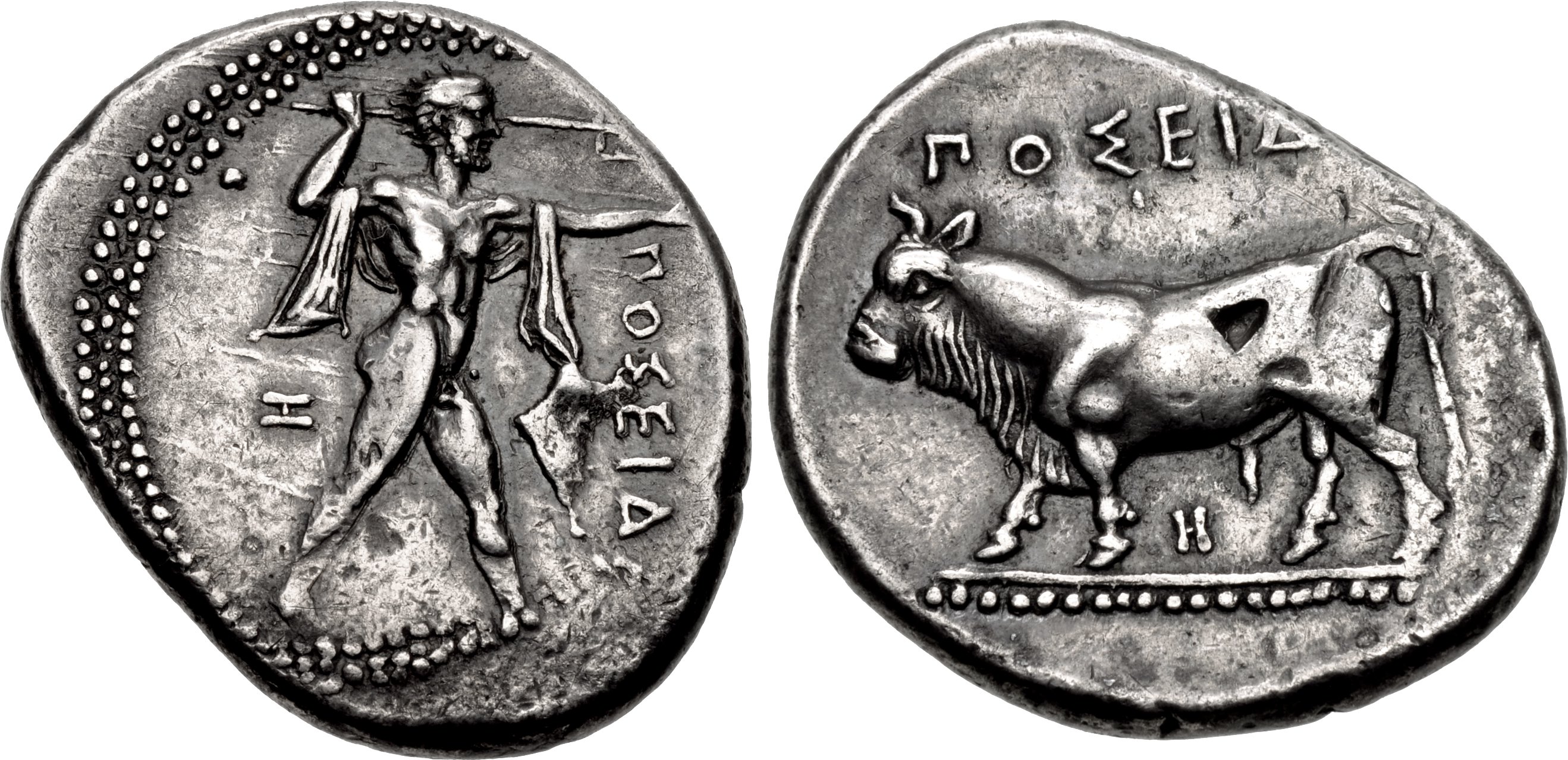AC 8 - Poseidonia, silver, staters (430-410 BCE)
From SILVER
430 BCE - 410 BCE Silver 3,173 kg
Description
| ObverseInscription or printing placed on the obverse.: | ΠOΣEIΔ (Greek).Poseidon, nude but for chlamys draped over both arms, standing right, preparing to cast trident held aloft in right hand, left arm extended, Z to left, ΠOΣEIΔA to right |
| ReverseInscription or printing placed on the reverse.: | ΠOΣEIΔA (Greek).Bull standing left on double exergue line, the lower dotted, ΠOΣEIΔ[A] above, H below |
Mint and issuing power
| MintIdentifies the place of manufacture or issue of a numismatic object.: | Poseidonia | Ancient regionAncient region.: | Lucania | Modern countryModern country: Italy | AuthorityIdentifies the issuing power. The authority can be "pretended" when the name or the portrait of X is on the coin but he/she was not the issuing power. It can also be "uncertain" when there is no mention of X on the coin but he/she was the issuing power according to the historical sources: |
Chronology
| FromIdentifies the initial date in a range assigned in a numismatic context. | 430 BCE | toIdentifies the final date in a range assigned in a numismatic context.. | 410 BCE | PeriodTime period of the numismatic object.: Classical 480-323 BC |
Physical description
| MetalThe physical material (usually metal) from which an object is made.: | Silver |
Median weightMedian of the weights of numismatic objects (in grams). in grams | 7.75 | DenominationTerm indicating the value of a numismatic object. Examples: tetradrachm, chalkous, denarius.: | stater |
StandardStandard.: |
Image

AC 8 - Poseidonia, silver, stater, 430-410 BC.jpg [1]
References
| Die study referencePublication of the study: | Noe 19521Noe 1952 | ||
| Coin series referenceReference to coin series study: | Sear I2Sear I, n° 424, RQEMAC3RQEMAC, n° 8, HN Italy4HN Italy, n° 1127 | ||
| Coin series web referenceCoin series web references: | |||
Obverse dies distribution
| FrequencyFrequency of specimen in distribution. ᵖ | Number of obversesNumber of obverse dies. ᵖ (o) | % (o) | Number of coinsNumber of coins. (n) | % (n) | Die nameName(s) of the die(s). |
| 1 | 4 | 22.22 | 4 | 5 | 16, 26, 27, 28 |
| 2 | 2 | 11.11 | 4 | 5 | 5, 29 |
| 3 | 3 | 16.67 | 9 | 11.25 | 1, 14, 17 |
| 4 | 2 | 11.11 | 8 | 10 | 12, 18 |
| 5 | 1 | 5.56 | 5 | 6.25 | 6 |
| 6 | 2 | 11.11 | 12 | 15 | 10, 19 |
| 7 | 1 | 5.56 | 7 | 8.75 | 3 |
| 8 | 1 | 5.56 | 8 | 10 | 7 |
| 10 | 1 | 5.56 | 10 | 12.5 | 20 |
| 13 | 1 | 5.56 | 13 | 16.25 | 23 |
| Total | 18 of 18 | 100.02 | 80 of 80 | 100 |
Reverse dies distribution
no distribution is available
Quantification
| Number of obversesNumber of obverse dies. ᵖ (o) | 18 | Number of singletons (o1)The number of singleton coins. ᵖ | 4 |
| Number of reverse diesNumber of reverse dies. (r) | NC"NC" is not a number. | Number of coinsNumber of coins. (n) | 80 |
| Coins per obverse dieNumber of coins per obverse die. (n/o) | 4.44 | Coins per reverse dieNumber of coins per reverse die. (n/r) | |
| Reverse per obverse ratioRatio of obverse dies divided by reverse dies. (r/o) | Percentage of singletons (o1)number of coins (n) divided by the number of singletons (o1) ᵖ | 22.22 % | |
| Original number of dies (O) (Carter 1983 formula)The estimation of the number of coins according to Carter 1983 ᵖ | 20.47 | Coins struck if 20,000 as average productivity per dieCoins made if the average productivity for obverses (according to Carter) is 20,000. ᵖ | 409,400 |
| Original number of dies (O) (Esty 2011 formula)The estimation of the number of coins according to the singleton formula in Esty 2011 ᵖ (O) | 23.23 | Survival rate if 20,000 as average productivity per dieSurvival rate if average productivity is 20,000. ᵖ | 0.00020 |
| Coverage (o = % of O) (Esty 1984 formula)Esty 1984 - coverage (% of O) ᵖ (o = % of O) | 95% | Die productivity if survival rate 1/2,000Average productivity if survival rate is 1/2,000. ᵖ | 7,816.32 |
| Weight of silver (in kg) if 20,000 coins per die (O = Carter formula)Carter 1983 * Median weight * 20000 (*10 if gold or electrum) ᵖ | 3,173 kg <br /> 3,173 kg | Die productivity if survival rate 1/5,000Average productivity if survival rate is 1/5,000. ᵖ | 19,540.79 |
Remarks